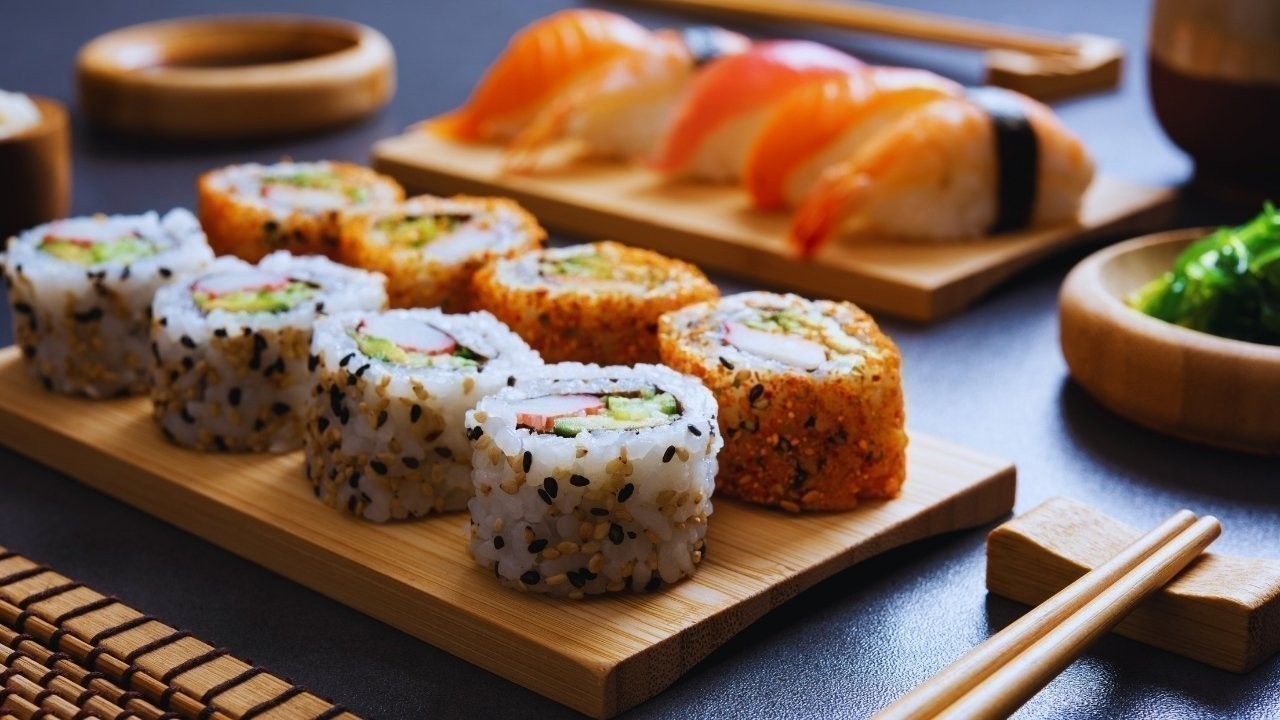
Post by : Anis Karim
In a bustling city centre just after dinner rush, a small door opens to reveal an intimate sushi bar. The soft light, the low‑ceiling, the bare wood counter seating only twenty or so – no large banquet tables, no loud music, no sprawling dining room. Guests arrive without formal reservations and take a seat facing a master chef slicing fish, rolling rice, engaging quietly with each diner. This micro‑sushi format is quietly gaining momentum. Why are diners drawn to it? What makes it viable for operators? And how might it change the broader dining scene? In this article we unpack the rise of walk‑in, 20‑seat sushi bars, what they deliver, and the implications for the future.
Several factors are converging to make the small‑format sushi bar more than a novelty – it’s becoming a model. First, diners today increasingly seek not just food, but experience and craftsmanship. A smaller seating capacity lends itself to precision, interaction, and a sense of being part of something curated. Second, social‑media and design‑led culture reward intimate, well‑shot settings; a 20-seat bar often offers photogenic counter‑seating, visible chef work and a “workshop” vibe rather than a generic dining room. Third, from a business viewpoint, smaller spaces mean lower rent, fewer tables to staff, and tighter operational control—when done right. Finally, in regions such as India and Asia, the growth of Japanese cuisine and urban food‑enthusiast culture means there is both interest and willingness to pay for craft sushi‑experiences. For instance, the broader sushi‑restaurant market in 2025 is projected to grow, driven by health‑led diners, urbanization and digital adoption.
This model has a few defining features. Counter‑seating often facing the chef, with a small number of seats (typically 12 to 20). Walk‑in policy (sometimes with a short wait‑list) enhances spontaneity and reduces barrier of formal booking. Chef‑led menus with premium ingredients – nigiri, hand‑rolls, small sets rather than large share platters. This creates a feeling of craft and immediacy. Guests feel less like one table among many, and more like participants in a dining moment. From the operator side, there’s better control over every dish, shorter menu cycles, closer customer feedback and opportunities for high per‑seat spend. In a culture where diners increasingly value authenticity, being able to converse with the chef, see the fish being cut, watch rice moulded by hand, these elements matter.
From the consumer side, the appeal is multi‑layered. There is a desire for authenticity and rarity—seating limited, so it feels special. There’s a sense of connection—sitting at the counter invites a closer view, small group, more personal service. There’s the experience factor—in a world of chain restaurants and mass‑market dining, a 20‑seat bar stands out, becomes memorable. And crucially, it aligns with social‑behaviour trends: diners are increasingly after shares, posts, stories—this format meets that. In cities like Mumbai and Bengaluru, Japanese cuisine is still being discovered in new formats; intimate sushi counters make it less intimidating and more desirable.
Running a 20‑seat walk‑in sushi bar calls for precise mechanics. Space and seating: with only around 20 covers, the location need not be a large footprint; this lowers rental and fit‑out cost. Turnover and check size: With fewer seats, operators aim for higher average spend per cover rather than volume. Menus might be priced at premium levels, with seasonal fish and chef‑special items. Staffing and craft: fewer seats means fewer staff but also increased pressure on the chef and team to deliver consistently. Skill becomes a differentiator. Inventory & sourcing: Premium seafood is costly, so careful sourcing, menu engineering and waste control are vital. Marketing & ambience: Because of limited seats, often there is a “buzz” or word‑of‑mouth element; many such bars rely on social media traction, minimalist décor, chef persona. Risk and scalability: The model’s strength is intimacy; its weakness is dependence on small margin of error. With limited seats, a bad night is proportionally bigger hit. Also scaling this format (opening many such bars) can dilute the exclusivity and craft perception.
In India and Asian cities, this trend has special relevance. Reports show that micro‑dining restaurants (8‑20 seats) are emerging in India, driven by chefs seeking more direct interaction and diners seeking niche experiences. Many Japanese (sushi) restaurants in Mumbai, Bengaluru and Delhi are now focusing on luxury and counter‑seating formats. A recent guide to Japanese restaurants in Mumbai pointed out how sushi‑counters and omakase‑bars are being redefined in 2025. These regional factors mean that the micro‑sushi bar model is not only viable but may be timely: rising middle‑/upper‑income urban diners, increasing interest in Japanese cuisine, and appetite for craft experiences. However local challenges exist: sourcing premium fish (especially in land‑locked or remote areas), pricing sensitivity in mass market, and creating the right ambience without ballooning costs.
While the trend is compelling, the micro‑format is not without risk. The small seat count means limited revenue volume – everything hinges on check size and consistency. A mis‑step in service, ingredient quality or timing can hurt reputation quickly. The model is highly reliant on the chef and front‑counter team; turnover here hurts badly. Ingredient costs (premium seafood) and cold‑chain logistics are high. Also, because the format leans premium, pricing must reflect value without alienating local audience. Another risk: novelty can wear off. If many venues adopt 20‑seat formats, the exclusivity fades. Also, expansion or franchise models may undermine craft feel. Strategically, it is a concept that fits certain neighbourhoods, foot‑traffic patterns and target segments—not every locale will support it.
The rise of walk‑in, 20‑seat sushi bars signals a broader shift in dining: from scale to craft, from seats to experience, from mass markets to curated encounters. Larger restaurant chains will likely respond by creating “mini” versions or chef‑counter pop‑ups. The small‑format trend might expand beyond sushi into other cuisines: fine Indian tasting menus, small pasta‑bar counters, craft tacos with chef‑interaction. For diners, it means more choices: fewer generic dining rooms, more curated, intimate spaces. For the market, it could shift expectations: reservations will still exist, but walk‑in, shorter turn times, high craft experience will become desirable. For the sushi segment specifically, this format raises the bar for quality, sourcing transparency, and guest engagement.
What should we watch for in the coming 12‑24 months? First: Will we see a proliferation of 20‑seat sushi bars in tier‑2 cities and suburban markets? If so, how will they adapt costs and pricing? Second: Will technology (booking‑apps, wait‑lists, digital counters) enhance the walk‑in model, making it scalable without losing intimacy? Third: Will we see fusion and localisation—small sushi bars adapting to local flavours, diets (vegetarian/vegan sushi), price points? Fourth: How will sustainability and sourcing shape this format? With limited seats and high per‑cover spend, provenance and eco‑credentials will likely become part of the story. Lastly: Will the format evolve beyond sushi into other cuisines or hybrid dining experiences where craft + intimacy becomes norm?
The walk‑in, 20‑seat sushi bar is more than a gimmick—it’s a response to changing diner desires and industry economics. It offers craft, connection and exclusivity in a small footprint. For operators, it offers a manageable model with potential premium margins, provided the seat count, sourcing and guest experience are controlled tightly. For diners, it offers something memorable, personal and shareable. As this format spreads—or morphs into adjacent cuisines—it may well reshape how urban diners think of eating out: less about size, more about substance. Whether you’re a sushi‑lover, a restaurateur or simply someone curious about dining trends, these compact, chef‑led counters are worth a visit (and a story).
The information provided in this article is for general informational purposes only. It does not constitute business, investment or culinary advice specific to any individual or situation. Readers and operators should seek professional consultation when making business, financial or operational decisions.

Mastiii 4 trailer out Riteish, Vivek, Aftab reunite for comic chaos
Riteish Deshmukh, Vivek Oberoi, and Aftab Shivdasani bring back their signature madness in Mastiii 4

Australian First Nations Fashion Takes Center Stage in India
Australian First Nations fashion merged art and culture on an Indian runway as Kirrikin marked its 1

Bhumi Pednekar stuns in ₹6.87 lakh wine Kanjeevaram saree at wedding
Bhumi Pednekar turned heads in a ₹6.87 lakh wine Kanjeevaram saree at Vedant Birla and Tejal Kulkarn

Dubai Holding & Palantir Launch Aither, UAE’s AI Powerhouse
Dubai Holding and Palantir form Aither, UAE’s first AI JV, to drive enterprise AI adoption and boost

South Korea Sees Fastest Inflation Rise Since July 2024
South Korea’s consumer prices rose 2.4% in October, marking the fastest inflation growth in over a y

Sharjah to Host Landmark Arab-German Science & Humanities Meet
University of Sharjah readies Arab-German Conference, uniting 100+ researchers for science, innovati

Taylor Swift & Gigi Hadid Dazzle in Coordinated NYC Dinner Outfits
Taylor Swift and Gigi Hadid turned heads with matching fashion in NYC. The longtime friends dined at

UAE Life High Stress 3 Simple Ways Expats Can Manage Pressure
Expats in the UAE face daily pressure and burnout Learn 3 simple effective ways to manage stress fin

Smart Meal Prep in Dubai Save Money Stay Healthy
Plan smart eat fresh Discover how meal prepping in Dubai helps you save money eat healthy and enjoy

The Ultimate Guide to Dieting in Dubai Keto vs Vegan vs Mediterranean
Discover Dubai’s top diet trends Keto Vegan and Mediterranean Find which plan fits your lifestyle f

Stay Fit in Dubai 7 Fun Outdoor Workouts Without a Gym
Explore 7 fun ways to stay fit in Dubai from beach runs to desert hikes and skyline yoga No gym nee

Beyond Biryani: Mastering Portion Control in Dubai’s Melting Pot of Cuisines
Discover how to enjoy Dubai’s diverse cuisines wisely Learn simple portion control tips to stay heal

Fabien Marchand — The Infinite Brushstroke of Freedom
French artist Fabien Marchand explores freedom, color, and emotion through his evolving art — bridgi

Dubai’s Healthy Food Revolution 5 Global Wellness Trends Transforming the City
Discover how Dubai is embracing a global wellness wave with plant based diets organic food and smart

Start Your Day with Chia Seeds for Stronger Healthier Hair Naturally
Discover how morning chia seeds boost hair growth add shine and strengthen roots naturally with easy